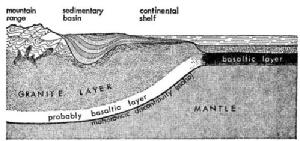Moholes
In the mid twentieth century analysis of earthquake shockwaves revealed that the Earth’s crust is no more than a thin skin, lying atop a thick mantle which itself englobes a dense core. Even before the boundary between the crust and mantle - the Mohorovičić Discontinuity - was scientifically identified, ideas of boring a “mohole” to reach it have attracted attention from both scientists and science fiction.
The earliest fiction to explore deep below the Earth’s surface was highly speculative. Most, like Verne’s Journey to the Centre of the Earth or Bulwer-Lytton’s The Coming Race, fall into the tradition of Hollow Earth stories, which combine elements of fantasy with science fiction. These often imagine enormous caverns, complete with oceans, animal life and sentient races, just a few miles below the surface, and accessible through surface mines or natural volcanic shafts.
An early narrative to scientifically explore the possibility of deep artificial borings further into the Earth’s depths can found in When the World Screamed (Arthur Conan Doyle, 1928, text). In this novella, Professor Challenger, who featured in Conan Doyle’s earlier The Lost World (1912), develops a theory that Earth resembles a sea urchin or echinus - a sea creature with a soft body and a thin, rigid shell. He launches a project to drive a shaft deep into this shell to discover what’s inside. Recruiting mining experts and an artesian well boring specialist, Mr Peerless Jones [1], he oversees the construction of a shaft eight miles deep. Penetrating the crust, they find a soft, organic surface and drive a javelin-like probe into it… with results hinted at by the story’s title. Throughout, the story is told from the viewpoint of the artesian engineer, and built on then-cutting-edge knowledge both about geology and about the boring process.
The idea that tunnelling into the Earth could bring both scientific and commercial benefits recurred periodically, although fanciful notions such as a living or hollow core became less readily acceptable as time went by, even if the true facts remained fuzzy. In Tom Swift and his Atomic Earth Blaster (juvenile novel, 1954), for example, the young inventor of Victor Appleton’s series of juvenile science fiction decides to turn his attention to tunnelling. While shallow tunnels are easy to produce in Swift’s atomic-powered, industrially advanced universe, the new device actually tunnels through the Earth’s crust to the mantle below, producing a fountain of pure liquid iron that is collected for industrial purposes. Neither the depth of tunnel required, nor the true composition of the mantle rock (largely silicon-based) were accurately represented, although both were well understood scientifically by this point, as Project Mohole demonstrated.
Project Mohole
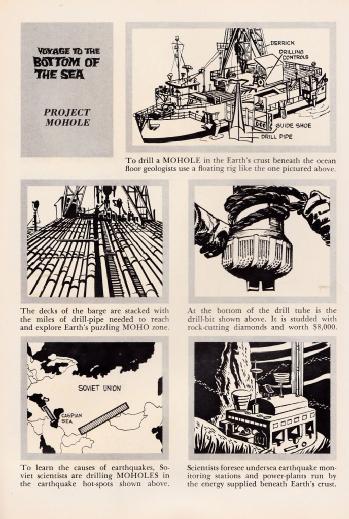 The Mohorovičić Discontinuity, colloquially known as the Moho, is a boundary within the Earth at which the transmission speed of earthquake waves abruptly changes, suggesting a change in the composition or state of the material. It was first defined as early as 1909 by Croatian geologist Andrija Mohorovičić, and in the 1950s came to attention in the context of then then-new model of continental drift. In the late 1950s, the US funded Project Mohole - an effort to drill through one of the relatively shallow basaltic plates that underlie the oceans. By reaching the bottom of the crust, the prestige project aimed to secure a sample of rock material unprocessed by water or biology, massively increase our geological knowledge, and explore the possibility of such a boring as a source of energy or mineral resources.
The Mohorovičić Discontinuity, colloquially known as the Moho, is a boundary within the Earth at which the transmission speed of earthquake waves abruptly changes, suggesting a change in the composition or state of the material. It was first defined as early as 1909 by Croatian geologist Andrija Mohorovičić, and in the 1950s came to attention in the context of then then-new model of continental drift. In the late 1950s, the US funded Project Mohole - an effort to drill through one of the relatively shallow basaltic plates that underlie the oceans. By reaching the bottom of the crust, the prestige project aimed to secure a sample of rock material unprocessed by water or biology, massively increase our geological knowledge, and explore the possibility of such a boring as a source of energy or mineral resources.
Project Mohole was a high-profile scientific effort, supported by government funding from 1958. It was widely reported in the media of the time and in popular science contexts, as well as in science fiction magazines and journals. While the benefits of the project were, perhaps, a little difficult to explain to the public, they aligned well with the publicity that Earth sciences received during the International Geophysical Year of 1957-8.
Phase I of the project successfully demonstrated novel techniques for underwater drilling (a necessity since oceanic plates are significantly shallower than continental plates), reaching a depth of 183m. Unfortunately, the lead scientific organisations for the project were unaccustomed to dealing with the organisation of an industrial effort on this scale, and there were disputes over the choice of contractors and design of the project. By 1964, the project had run into serious trouble. Administrative issues, a number of technical problems, associated spiralling costs and very slow drilling process led to cancellation of Phases II and III, and the abandonment of the project in 1966. Public attention and funding was diverted to the far more visibly successful space program.
While further deep drilling programs have been undertaken since the end of Project Mohole, the objective of reaching the mantle itself has been largely abandoned, with a focus on shallower sub-ocean geology. One, the US Deep Sea Drilling Project (1968-1993) had more modest goals and was deemed highly successful, reaching a depth of 1.7 km, and has been built on by successor programmes. The most successful deep drilling effort, the USSR’s Kola Superdeep Borehole project (1970-1995), reached 12.3 km (about a third of the thickness of the local crust), with a number of narrow boreholes, although repeatedly encountering problems when drills broke, blocking the deepest holes from proceeding further.
Science Fictional Moholes
Perhaps unsurprisingly, for a high-profile effort, Project Mohole inspired a large number of related narratives in 1960s science fiction.
The long-running science fiction television series Voyage to the Bottom of the Sea included references to no fewer than three different moholes, for involvement with which the SSRN Seaview, as a deep-diving nuclear submarine, was particularly well-suited. In the episode "Leviathan" (1965) a natural fissure is found which extends through the Earth’s undersea crust and all the way to the core. The fissure has “some emission” which causes rapid growth in animal life in the vicinity. While the fissure in this case is natural, the characters note that “hundreds of millions” of dollars had been spent in pursuit of the same goal. Later in the same season, the episode "The Mechanical Man" (1966) features a self-aware android character supervising a deep underwater drilling project. He has identified a new element - subterranium-116 [2] - in the borings which can act as a vast power source for him, and he has no qualms about human lives expended to acquire it. We’re told that the project, governed from “Geophysical Headquarters” and with some kind of UN remit, has had contributions from many nations, and has cut through the Earth’s mantle. Unfortunately the high pressure in the drill shaft risks triggering “volcanoes… earthquake… tidal waves”, and the shaft must ultimately be sealed against the android’s determined opposition.
In both these cases, while the wider project may be large, the research site itself is a small-scale affair, driven meglomaniacally by just one scientist (and an assistant) with an ulterior motive of their own. In neither case is the outcome entirely plausible, although the identification of new minerals is perhaps a little more likely than unrestrained growth (albeit probably not in the form of a hitherto undiscovered element).
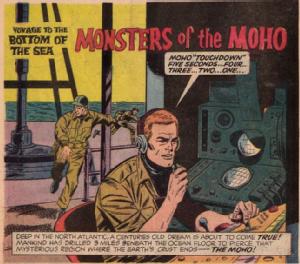 An additional notable appearance, this time in spin-off media, came in the comic book associated with the series. The story “Monsters from the Moho” (comic, 1965) was accompanied by a brief feature on the real Project Mohole and described the series’ submarine Seaview responding to a distress call from the project’s drilling ship after it penetrates the discontinuity and suddenly becomes magnetised. The drill shaft is sealed, but not until Seaview and the surrounding sealife become contaminated, causing fish to regress to prehistoric forms and the ship to be swamped in a green mould. Rather predictably for the series, the ultimate solution proves to be the detonation of an atomic bomb in the Moho itself.
An additional notable appearance, this time in spin-off media, came in the comic book associated with the series. The story “Monsters from the Moho” (comic, 1965) was accompanied by a brief feature on the real Project Mohole and described the series’ submarine Seaview responding to a distress call from the project’s drilling ship after it penetrates the discontinuity and suddenly becomes magnetised. The drill shaft is sealed, but not until Seaview and the surrounding sealife become contaminated, causing fish to regress to prehistoric forms and the ship to be swamped in a green mould. Rather predictably for the series, the ultimate solution proves to be the detonation of an atomic bomb in the Moho itself.
Indeed, producer of Voyage to the Bottom of the Sea, Irwin Allen, appears to have been rather taken by the idea. A sabotaged mohole project formed the subject of a 1967 ten minute pilot filmed for a never-made television series: City Beneath the Sea. A second, much longer pilot was made as a feature-length film in 1971, but replaced the mohole threat with an extraterrestrial one. Again, though, the prospective series failed to attract commercial interest.
British children's science fiction latched on to the topic with 1962's television drama serial Secret Beneath the Sea (made by the UK's ABC Television). This sequel to an earlier serial named City Beneath the Sea (and with no connection to the later American drama of the same name) recast the underwater outpost of Aegiria, in the mid-Pacific, as the site for a scientific mohole research drilling project. Here the plot driver was a new metal, phoenicium, found in a layer beneath the city, and various conspiracies regarding its scientific discovery and commercial exploitation. By design, the series had an education remit, with characters occasionally bursting into brief explanations of the science of underwater exploration, and the inclusion of a mohole emphasises the subject's contemporary relevance.
Another contemporary reference was the 1965 disaster film Crack in the World. In this film, a drilling endeavour - Project Inner Space - that aims to tap geothermal energy runs into trouble with unexpectedly dense rock strata. In an effort to break through it, the decision is made to detonate a nuclear weapon deep in the shaft. Unlike in the Voyage to the Bottom of the Sea comic mentioned above, this is a bad move. Given the title of the film, the result is predictably catastrophic. The apparent moral of the story is more or less summarised in the tagline of the film’s original trailer: “Science’s Dream of Limitless Power… becomes Mankind’s Nightmare of Unimaginable Terror!”
A similar deeply negative view of mohole drilling efforts is reflected in the Fritz Lieber novel A Specter is Haunting Texas (1969). In this satirical narrative, World War III has left humanity divided between the devastated earth and circumlunar extraterrestrial human settlements. The United States of America no longer exists and its remains have been subsumed by a bizarrely changed Texas. Texan versus Mexican racial tensions have been amplified by physical mutations. Mohole mines are drilled for radioactive materials, which gush from the shafts in a narratives which explicitly equates the outcome with Texan oil wells. While no real detail is provided of the technology involved, the “gushers” become a prestige project and one which could threaten all of the orbital habitats. The probable nature of the mantle and the enormous pressure of the ferrous and radioactive ores that might be forced up a shaft by convective currents in the mantle are explictly discussed - particularly with reference to replenishing Earth’s war-depleted resources:
“It is a commonplace,” he began, “that common men never perceive the wonders of science and technology until the rockets roar, until the nuclei give up their energy at interior solar heat, or until the rich thor-uranic lava spouts from a mohole.” (pg 189)
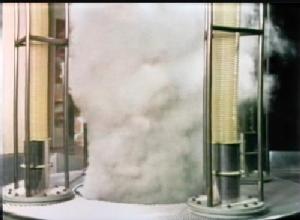 At least one writer for the long running television series Doctor Who was influenced by the real Project Mohole. The Third Doctor serial "Inferno" (1970) by Don Houghton was based in and around a secret project to drill towards the Earth’s core in order to provide a cheap and plentiful power source. The development of this story was apparently inspired by the genuine project, and in particular by the secrecy which surrounded its rather embarrassing failure - indeed the script was originally entitled The Mo-Hole Project. In the story, an exudate from the mine causes scientists to revert to a rather apeman-like primitive humanoid form. At the same time, the Doctor’s attempts to use the power released by the borehole to restore his TARDIS result in his relocation to a hostile and militaristic parallel universe in which the drilling project is more advanced. Eventually it reaches penetration of the crust and, as the Doctor tells us, "compared with the forces you people have released, an atomic blast would be a summer breeze."
At least one writer for the long running television series Doctor Who was influenced by the real Project Mohole. The Third Doctor serial "Inferno" (1970) by Don Houghton was based in and around a secret project to drill towards the Earth’s core in order to provide a cheap and plentiful power source. The development of this story was apparently inspired by the genuine project, and in particular by the secrecy which surrounded its rather embarrassing failure - indeed the script was originally entitled The Mo-Hole Project. In the story, an exudate from the mine causes scientists to revert to a rather apeman-like primitive humanoid form. At the same time, the Doctor’s attempts to use the power released by the borehole to restore his TARDIS result in his relocation to a hostile and militaristic parallel universe in which the drilling project is more advanced. Eventually it reaches penetration of the crust and, as the Doctor tells us, "compared with the forces you people have released, an atomic blast would be a summer breeze."
Witnessing the appalling death and destruction caused when the drill reaches its target, the Doctor must race to prevent catastrophe on his return to his own timeline.
The elements of reverted anthropoid “primords” were added to expand the original running time during script development, rather than part of the original concept, and are probably the least convincing elements. On the other hand, the imagery of pollutants bubbling out of the borehole, and the catastrophic conclusion of the project reflect the growing environmental fears of the time, as well as the fear of the unknown associated with any large-scale project which aims to probe hitherto unexplored regimes.
A similar project was described, albeit in less detail, in the much more recent two-part Doctor Who story "The Hungry Earth" and "Cold Blood" (2010), written by Chris Chibnell. While this featured a deep boring project, designed to investigate unusual minerals in the Welsh village of Cwmtaff, its primary plot role was as the source of an accidental intrusion into an enormous underground Silurian settlement. The establishment required for the borehole was substantially smaller and less well staffed than any real-world effort with similar objectives, although apparently deleted material would have addressed a funding shortfall. However, the story in this case focused on the interaction between the humans and Doctor Who’s recurrent Earth-native reptile people, rather than on the borehole itself or the Earth sciences.
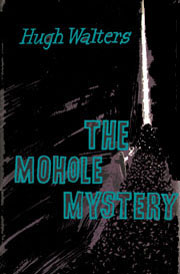 Given the frequent narratives of negative results of mohole projects during the 1960s, it’s interesting to also note a contemporary counter example. Hugh Walters’ series of children’s novels involving Chris Godfrey of the United Nations Exploration Agency, Unexa, were almost entirely focused on rocket flight and dealing with threats from, or explorations of, outer space. However The Mohole Mystery (Walters, 1968, text) instead turned the exploration inwards. After ocean-based mohole attempts have failed due to dense underlying rock layers (reflecting the already largely abandoned status of Project Mohole at the time of writing), a local gravitic anomaly is identified beneath Dudley in the West Midlands. An initial test bore (accessed through the industrial town’s zoo!) reveals a vast cavern deep below the Earth and is expanded to a 24 inch borehole. This permits a narrow, single-passenger rocket-equipped capsule to be sent down into the methane atmosphere of the cave, carrying a subterranaut.
Given the frequent narratives of negative results of mohole projects during the 1960s, it’s interesting to also note a contemporary counter example. Hugh Walters’ series of children’s novels involving Chris Godfrey of the United Nations Exploration Agency, Unexa, were almost entirely focused on rocket flight and dealing with threats from, or explorations of, outer space. However The Mohole Mystery (Walters, 1968, text) instead turned the exploration inwards. After ocean-based mohole attempts have failed due to dense underlying rock layers (reflecting the already largely abandoned status of Project Mohole at the time of writing), a local gravitic anomaly is identified beneath Dudley in the West Midlands. An initial test bore (accessed through the industrial town’s zoo!) reveals a vast cavern deep below the Earth and is expanded to a 24 inch borehole. This permits a narrow, single-passenger rocket-equipped capsule to be sent down into the methane atmosphere of the cave, carrying a subterranaut.
One of the team, Serge, is sent, but runs into trouble, encounters strange microbial and simple life, and must later be rescued by his colleagues Chris and Tony. The somewhat educational remit of the series (which was aimed at boys) is reflected in discussions between the characters of geology, the capsule’s methane-powered propulsion mechanism, microbial life and the decontamination procedures adopted in this timeline on both spacecraft and the subterranean capsule in the interests of planetary protection. While the initial exploration effort runs into trouble, by the end of the novel most of the problems encountered have been resolved, the goal of drilling to the Moho is never questioned, and it is clear that future exploration of this deep cavern will be undertaken when the shaft has been widened.
Moholes into the Twenty-first Century
Moholes have continued to appear in science fiction, albeit at a much lower rate, since the initial flurry of interest inspired by the project died down.
While the novel Ratner’s Star (1976) by Don deLillo uses the term “Mohole”, it is apparently referring - either through analogy or by simple mistake - to what is effectively a black hole or quantum singularity instead, suggesting that by then the term had fallen out of widespread use. In the novel, the singularities are named after the scientist who discovered them.
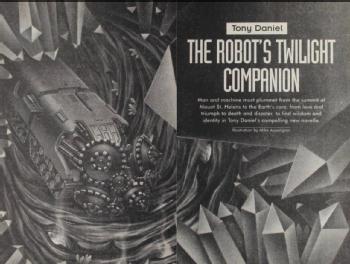 By contrast, Tony Daniel’s novel The Robot’s Twilight Companion (appearing in Asimov’s in 1996, published as a novel in 1999) returns the term to its correct geological usage. The novel follows the journey to self-awareness of a mining robot. Initially abandoned to rust when an environmentalist movement “Culture of the Matriarch” forces the closure of its owners, the robot is revived and its memories complemented by an impression of a human mind when it is repurposed for drilling a mohole. The project is profoundly opposed by the now-powerful “matties”:
By contrast, Tony Daniel’s novel The Robot’s Twilight Companion (appearing in Asimov’s in 1996, published as a novel in 1999) returns the term to its correct geological usage. The novel follows the journey to self-awareness of a mining robot. Initially abandoned to rust when an environmentalist movement “Culture of the Matriarch” forces the closure of its owners, the robot is revived and its memories complemented by an impression of a human mind when it is repurposed for drilling a mohole. The project is profoundly opposed by the now-powerful “matties”:
“These people feel that the work you're doing is violating the sanctity of the earth. They feel that you are, in a way, raping the mother of us all.” (Asimov’s SF, August 1996, pg 133)
The hole itself, drilled in the Olympic Peninsula of Washington state in the US, is described as a spiral reaching more than forty miles deep. The story imagines a 2013 in which the machine can be fusion powered, and create a diamond-glass lining that prevents the tunnel’s collapse. From the point of view of the robot, the climax of the narrative is a little confusing. At virtually the same moment as the robot detects a sentience deep in the rock close to the moho boundary, a bomb attack on the mohole by the anti-technology ‘matties’ and a series of vast and catastrophic earthquakes destroy the endeavour and the entire culture above. Cause and effect are deliberately left vague, although the implication is strong that the same movement that aimed to defend the Earth has ended up destroying it.
Another attempt to reach deep below the Earth’s crust can be found in one of the more amusingly bad science films of recent times. The Core (2003) imagined that the Earth’s core had suddenly stopped spinning, resulting in a collapse of the planet’s magnetic field. The resulting disruption affected navigation and led to severe irradiation of the surface. A mission is launched to restart the rotation using nuclear detonations, which must be planted by a team tunnelling in a machine constructed of the mythical unobtanium. The discussion of scientific inaccuracies in this film has already filled volumes, although it does manage to correctly describe an outline of the interior structure of the planet (if not show it on screen). Unlike any of the examples above (except possibly Tom Swift and his Atomic Earth Blaster) the exploration here is via a self-tunnelling machine which does not attempt to keep its tunnel open, rather than through a deep borehole.
 However perhaps the most scientifically accurate and influential use of moholes in recent fiction has been in Kim Stanley Robinson’s trilogy tracing the evolution of a Martian terraforming effort - Red Mars (1992), Green Mars (1993) and Blue Mars (1996). The terraforming of Mars for human habitation requires many modifications of the environment, but key amongst these are the heating of the surface and the thickening of atmosphere. Robinson proposed using deep bore moholes to penetrate the Martian crust. This is designed to release heat from the Martian mantle and also to allow outgassing of elements trapped at pressure in the deep rock strata. The interior structure of Mars is similar to that of Earth, with a crust between six and thirty miles in thickness, overlaying a mantle and a core. While the small planet Mars has cooled more rapidly than Earth, and no longer has active plate tectonics, it nonetheless remains hot at mantle depths. Thus moholes might well work as Robinson proposed, although shafts of sufficient depth and width to have a significant effect lie well beyond our current capabilities on Earth, let alone on Mars. Indeed Robinson doesn’t underestimate the requirements. He describes his moholes as descending from a vast surface funnel, a kilometre wide and seven kilometres deep, with eight successive elevators leading down into it, and constant work from robotic mining equipment to expand. Dump trucks take five hours to climb the winding road:
However perhaps the most scientifically accurate and influential use of moholes in recent fiction has been in Kim Stanley Robinson’s trilogy tracing the evolution of a Martian terraforming effort - Red Mars (1992), Green Mars (1993) and Blue Mars (1996). The terraforming of Mars for human habitation requires many modifications of the environment, but key amongst these are the heating of the surface and the thickening of atmosphere. Robinson proposed using deep bore moholes to penetrate the Martian crust. This is designed to release heat from the Martian mantle and also to allow outgassing of elements trapped at pressure in the deep rock strata. The interior structure of Mars is similar to that of Earth, with a crust between six and thirty miles in thickness, overlaying a mantle and a core. While the small planet Mars has cooled more rapidly than Earth, and no longer has active plate tectonics, it nonetheless remains hot at mantle depths. Thus moholes might well work as Robinson proposed, although shafts of sufficient depth and width to have a significant effect lie well beyond our current capabilities on Earth, let alone on Mars. Indeed Robinson doesn’t underestimate the requirements. He describes his moholes as descending from a vast surface funnel, a kilometre wide and seven kilometres deep, with eight successive elevators leading down into it, and constant work from robotic mining equipment to expand. Dump trucks take five hours to climb the winding road:
“The sheer size of the shaft was hard to grasp: the muted light and vertical lines reminded him of a cathedral, but all the cathedrals ever built would have sat like dollhouses at the bottom of this great hole.” (Red Mars, Voyager 1996 edition, pg 282).
The shaft itself at this point of the narrative had reached only twenty percent of the way through the lithosphere.
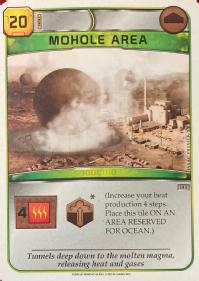 This proposal for using moholes as engines for terraforming has been influential elsewhere. In the science fictional board game Terraforming Mars (2016), inspired and heavily influenced by Kim Stanley Robinson’s Mars Trilogy, players (acting as a range of corporate or NGO entities) compete to earn terraforming points by raising the global fraction of oxygen, temperature and ocean coverage of the planet. One of the available projects is the development of a Mohole Area - as the card notes, this releases both gases and heat into the Martian atmosphere in the context of the game, as it does in Robinson’s novels.
This proposal for using moholes as engines for terraforming has been influential elsewhere. In the science fictional board game Terraforming Mars (2016), inspired and heavily influenced by Kim Stanley Robinson’s Mars Trilogy, players (acting as a range of corporate or NGO entities) compete to earn terraforming points by raising the global fraction of oxygen, temperature and ocean coverage of the planet. One of the available projects is the development of a Mohole Area - as the card notes, this releases both gases and heat into the Martian atmosphere in the context of the game, as it does in Robinson’s novels.
Interestingly, there has also been discussion of the possible negative effects of such a large-scale (macroengineering) project here and elsewhere. Writing in the Journal of the British Interplanetary Society, Cirkovic and Cathcart (2004) proposed that the gases released by a borehole to the mantle might differ from expectations - perhaps catastrophically so. This could have the effect of rendering a planet less rather than more habitable. Indeed they proposed this as a mechanism by which civilisations on geologically active planets might inadvertently destroy themselves, and thus as a partial solution to the Fermi Paradox.
Mohole Legacies
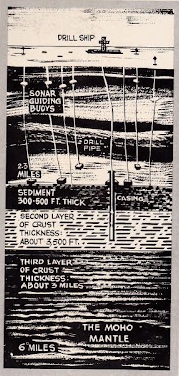 The legacies of Project Mohole have been complex. The project itself was an expensive, high profile political and science management failure in terms of its stated goal. Multiple studies have explored just where the project management (both of itself and of the expectations of its supporters) went wrong. It acts as a cautionary tale against raising expectations that cannot be met on reasonable timescales. The project nonetheless promoted interest in the Earth sciences and in drilling projects. Examples such as those associated with The Mohole Mystery and Voyage to the Bottom of the Sea: "Monsters from the Moho” illustrate its use for informal science education in the context of fictional representations.
The legacies of Project Mohole have been complex. The project itself was an expensive, high profile political and science management failure in terms of its stated goal. Multiple studies have explored just where the project management (both of itself and of the expectations of its supporters) went wrong. It acts as a cautionary tale against raising expectations that cannot be met on reasonable timescales. The project nonetheless promoted interest in the Earth sciences and in drilling projects. Examples such as those associated with The Mohole Mystery and Voyage to the Bottom of the Sea: "Monsters from the Moho” illustrate its use for informal science education in the context of fictional representations.
In fact, despite failing to reach the moho, Project Mohole’s phase I work was groundbreaking and successfully demonstrated important technologies. Indeed a series of subsequent successful boreholes, exploring both more deeply and more widely than the original mohole have brought unprecedented insights, and many of these built on the technical expertise and experience of the 1960s project. Mohole projects continue to be developed and discussed to the current day - but with less publicity and considerably lower public expectation than the original. While news headlines continue to discuss the possibility of reaching the Mohorovicic discontinuity, they now attract relatively little attention - perhaps reflecting a more realistic view of the expected rate of scientific progress.
However the overwhelmingly negative representations of possible mohole outcomes in science fiction strongly hint at public opposition to large scale macroengineering projects, and a significant wariness of the possible misuse of science and technology. The bulk of this was observed in the context of the Cold War era of the 1960s, where destructive technologies were under constant development and their use seemed likely. While positive motivations - primarily an environmentally friendly, abundant and reliable source of power - appear in narratives such as Voyage to the Bottom of the Sea and Crack in the World, this is not shown as offsetting the potential risk, and demonstrate the care needed in the construction of science exploitation narratives for communicating with the public. Such green power as a mohole offers might seem more tempting now than ever, but geothermal power hardly requires penetration to the mantle, when even moderately deep borings can generate substantial heat flows. Indeed the amount of debris and potential environmental damage caused by the mere process of boring could be considerable. A six-inch wide bore, twenty miles in depth, would generate around a thousand tonnes of debris, and potentially wider environmental impact from pollution and disruption around the drilling facility.
It is interesting that some of the more recent representations of moholes - and in particular of their use in terraforming have been more positive. However, as noted above, the form of macroscale geo- (or areo-) engineering described in some recent cases has been far beyond our current technology. Indeed Robinson’s trilogy forms part of a larger narrative of Mars colonization that sometimes inspires unrealistic expectations for the short term, in areas of industrial capacity, automation technologies, required political, financial and social dynamics and in terms of health risks to the colonists. Not that the Mars trilogy completely ignores the difficulties. Even in the narrative of Red Mars, the mohole operation finds itself the target of terrorist action trying to prevent its continuation.
Deep drilling continues in a number of sites, with the International Ocean Discovery Programme currently coordinating deep boreholes in some of the shallowest mantle sites on the planet. Some of these aim to reach the crust-mantle boundary - the Moho itself. The results might well revolutionise our understanding of geology - but the chances of any of the science fictional scenarios discussed to date resembling the true outcome are slim to say the least.
Mohole narratives capture the unease of their audience regarding the possible consequences of large scale scientific and engineering projects. But they also capture the fascination such large projects can inspire and the opportunity they offer for engaging the public with big science questions. Project Mohole’s legacy has extended far beyond its own brief fame, and could help inform future interactions between scientists, science fiction and the public into the distant future.
“Moholes”, Elizabeth Stanway, Cosmic Stories blog. 11th February 2024.
Notes:
[1] Artesian wells are deep, narrow borings to tap subterranean water supplies. [Return to text]
[2] Element 116 is, in fact Livermorium, identified in 2012 and has a half-life of 60 milliseconds. [Return to text]
Comments are always welcome. The views and opinions expressed here are those of the author, and not necessarily those of the University of Warwick. Images sourced online and used here for commentary and criticism.

